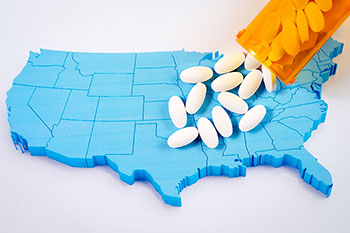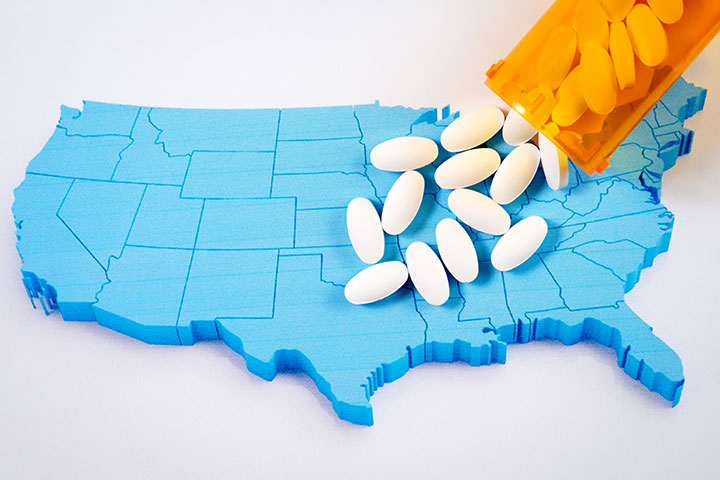How one hospital is taking a stand against the opioid epidemic.
Takeaways:
- Limited resources for the treatment of patients experiencing opioid withdrawal often results in referral to a rehabilitation center, which may cause treatment delays that lead to overdose death or suicide.
- The clinical scale developed by an interprofessional team made up of nurses, pharmacists, physicians, case managers, and social workers may help healthcare professionals caring for patients withdrawing from opioids.
As a nurse, seeing your own child deal with a substance use disorder is heartbreaking. However, losing one to an overdose because of a lack of understanding and resources for treatment is devastating. For this reason, two nurses (the authors of this article, one of whom lost a son as a result of an overdose) from SwedishAmerican Hospital, a division of the University of Wisconsin Health, a 333-bed acute-care hospital in Rockford, Illinois, wanted to make an impact on the U.S. opioid crisis. (See The opioid crisis: By the numbers.) The Rockford area serves many patients who are victims of the opioid epidemic. In Winnebago County (Rockford is the county seat), 34 of every 100,000 deaths per year are opioid related.
The focus of this article is on the development of a clinical scale to help nurses and other healthcare professionals care for patients withdrawing from opioids.
An interdisciplinary approach


How the protocol works
Nurses and providers can access the protocol to help promptly recognize withdrawal symptoms and then administer medications to control them. Using COWS, they rate withdrawal severity with a numeric score between 1 and 36. Medications are then prescribed accordingly. A reassessment is required every 6 hours for a score under 13 and once every hour for a score over 13. The provider is notified for scores over 36. Medications used in this protocol include clonidine, phenobarbital, loperamide, lorazepam, prochlorperazine, trazodone, ondansetron, and various analgesics for pain control. Labs include a drug test, along with HIV, blood alcohol level, and hepatitis B and C.
Case management and social services are integral to the opioid withdrawal protocol, assisting patients in establishing rehabilitation and counseling follow-up after discharge. This support opens the door for staff members to establish a therapeutic relationship with the patient that’s based on trust, which is often lacking in the lives of individuals with addiction disorders.
The opioid crisis: By the numbers
Healthcare providers are working collaboratively to decrease the number of unnecessarily prescribed narcotics and configuring withdrawal protocols to aid in managing hospitalized patients’ symptoms. Unfortunately, limited resources for the treatment of this patient population often results in referral to a rehabilitation center, which may cause a delay in treatment. As a result, patients may fall victim to accidental or intentional overdose or suicide.
500,000 number of opioid-related deaths projected in the United States over the next decade
64,000 approximate number of opioid overdose deaths in 2016 (The number of deaths related to prescription opioids has leveled out, but deaths related to heroin and fentanyl are still on the rise.)
#1 Opioid use was the number-one cause of accidental deaths in 2016
Sources:
Blau M. STAT forecast: Opioids could kill nearly 500,000 Americans in the next decade. statnews.com/2017/06/27/opioid-deaths-forecast/
National Institute on Drug Abuse. Overdose death rates. drugabuse.gov/related-topics/trends-statistics/overdose-death-rates
American Society of Addiction Medicine. Opioid Addiction: 2016 Facts and Figures. asam.org/docs/default-source/advocacy/opioid-addiction-disease-facts-figures.pdf
Education and implementation
After all members of the interdisciplinary team, including the head hospitalist, were in agreement, the newly developed opioid withdrawal protocol, using the COWS scale, was taken through the shared governance structure at SwedishAmerican for consideration by the standards and practice council.
After approval, clinical nurses throughout the organization received education through a self-learning computer module and presentations at staff meetings. In addition, providers were informed about the new protocol at their own monthly meetings, and flyers were posted throughout the hospital to remind staff of the November 1, 2016, “go live” date.
Take a stand
Since implementation, the protocol has been used on average eight times per month for patients admitted to the hospital with known opioid addiction.
A limitation to evaluating the results of this project has been difficulty following at-risk patients. Complicating factors include patients with varying diagnoses across the healthcare system, leaving against medical advice, and refusing recommended treatment or follow-up after discharge.
What we’ve learned at SwedishAmerican can assist other organizations that want to help their patients who suffer from opioid addiction and take a stand in the fight against the U.S. opioid epidemic.
Both authors work at SwedishAmerican Hospital, a division of UW Health in Rockford, Illinois. Barbara Leach is a nurse in the cardiac surveillance unit, and Lynn Lieb is a nurse in a medical/surgical unit.
Selected references
Blau M. STAT forecast: Opioids could kill nearly 500,000 Americans in the next decade. STAT. 2017.
National Institute of Drug Abuse. (2018). Misuse of prescription drugs.
National Institute of Drug Abuse. Overdose death rates. 2017.
Rudd RA, Aleshire N, Zibbell JE, Gladden RM. Increases in drug and opioid overdose deaths—United States, 2000-2014. MMWRMorb Mortal Wkly Rep. 2016;64(50-51):1378-82.
Kent J. 2016 National drug threat assessment.
Wesson DR, Ling W. The clinical opiate withdrawal scale (COWS). J Psychoactive Drugs. 2003;35(2):253-9.



















7 Comments.
Hello,
Is anyone willing to share their facilities protocol using the COWS tool?
Unfortunately, the authors have a personal bias. My most sincere condolences for the loss of a troubled son.
Punishing patients who suffering from chronic pain will not stop the so-called opiate crisis, nor will it bring back deceased addicts.
People must come before protocols.
While my heart goes out to those suffering from addiction, I have far more empathy for the real victims of this situation– patients suffering with chronic pain who are being denied adequate pain management due to the misuse of opiates by ADDICTS.
Can kratom help with opiate withdrawal Right now kratom is marketed as a safe way to overcome opioid addiction but researchers now warn that it may not be as safe as the packaging suggests
am writing in response to the article “The Clinical Opiate Withdrawal Protocol in an Acute-Care Setting”, written by Barbara Leach, and Lynn Lieb. The article can be found in the June 2018 journal Volume 13. I am writing, because the use of opioids and opioid dependence seems to be climbing quickly in the area in which I work and live. I would say that more than half of the patients I encounter have some degree of opioid dependence. I feel that the article is touching on a major issue in the nursing profession and that more information should be published regarding the opioid epidemic and how nurses can help.
I have had to opportunity to use the Clinical Opioid Withdrawal Scale (COWS) in a small hospital that almost always had an opioid withdrawing patient admitted. COWS is a basically a checklist of different withdrawal symptoms of different severities. Upon assessing your patient, you will check what symptoms and what severity they are having. The score they receive determines the treatment they will receive. A lot of times withdrawal symptoms can be missed, or no protocol will be put in place to care for the patient. This happens, because patients are not always truthful about their drug use, or the nurse simply is unaware of the type of protocol that needs to be used. I feel that most emphasis is placed on alcohol withdrawal protocol while opioids and other substances are often overlooked when it comes to making sure staff is competent in these protocols. Once the COWS protocol was put into place in the hospital I was at, I feel that more awareness was brought to these types of patients and better care was provided. The article “Opioid Use Disorder: Challenges During Acute Hospitalization” from the Journal for Nurse Practitioners states, “Unidentified and untreated illicit drug use is a major predictor for leaving against medical advice (AMA) and is linked to negative health outcomes including death” (2018, p. 62). This does not only apply to hospitals. In the article, “Opioid withdrawal deaths in jails: Preventable if medical standards followed” by Alison Knopf from the journal Alcoholism and Drug Abuse Weekly she writes, “there have been increasing reports of deaths in jails due to opioid withdrawal- deaths that could have easily been prevented by appropriate medical care” (2016, p. 5). It is evident that being aware of and treating withdrawal appropriately is essential for providing adequate care.
It is obvious that the opioid crisis is a growing issue in the medical field and not all nurses and providers are aware of how to treat it. As stated above, many deaths that occur from withdrawal could be prevented if the appropriate care is provided. I feel that the COWS scale is a great start to addressing and treating the issue. If more information were published regarding the opioid epidemic, I think more nurses would become aware and take initiative to implement protocols if they are not already in place.
Sincerely,
Taylor Lint, RN
I recently read “The Clinical opiate withdraw protocol in an acute-care setting” by Barbara Leach and Lynn Lieb in June 2018 Vol. 13 No. 6. I was excited to see the COWS (Clinical Opiate Withdraw Scale) being mentioned in American Nurse Today as opiate withdraw is an issue that every nurse may be faced with. I am glad that there is a scale in place for opiate withdraws that can be used to help this patient population during their recovery. Having this reference of symptoms to rank opiate withdraw allows for nurses to advocate for these patients and give them a higher standard of care. Although the article is a good way to get this information out, I am worried that not enough nurses are aware of this scale still that the scale itself was not printed with the article. It is important for this discussion to continue so that all nurses are aware of, and able to use this scale in their daily practice. I would like to see the actual scale printed in the magazine.
I think the article took the COWS scale in the right direction, possibly bringing it to some nurses that have not yet heard of it, but how do we as nurses ensure that it is being utilized in daily practice? I already had some experience with COWS prior to reading the article because the hospital I work for has a protocol with COWS, and the treatment to follow based on scoring. The scale used by my hospital is more condensed than the one listed in the PDF attached to the article. I did find the more detailed scale very educational and feel that it will help my nursing practice. An issue that does deserve mentioning is that in the article the actual scale was not printed, through the digital copy the reader could click on a PDF link to see the scale but this can be confusing and easily missed by some. After speaking with other nurses that work at other hospitals I found that many had never heard of COWS. I was able to easily pull up your article but then had to provide the PDF link to be able to see the scale itself to educate these nurses on COWS. It is our job as nurses to take this information and not only use it ourselves but present it for others to be used as a standard of care. With the rise of opiate use in our country it is important for nurses to be able to recognize the symptoms of withdraw. Nurses must have an understanding of the severity of withdraw based on symptoms to be able to care for this patient population. I challenge this journal to take a stand against opiates by continuing this discussion. I would like to see more articles that speak about addressing withdraw and see the actual scale in print in order for the information to be applicable to daily practice especially for those unfamiliar with COWS. Is there a way to create a poll on your website to see how many nurses are aware of this scale and using it already? I think having a poll accompanying the image of the scale would make for a great follow up article.
In conclusion, COWS is a great tool for nurses to use when assessing, planning, caring for, and even teaching patients, staff, and other faculty about the care of those suffering from opiate withdraws. However, this scale needs to be made more aware to healthcare providers, nurses especially. I look forward to seeing more articles on this topic of opiate withdraw from your journal with the actual scale being printed in the journal. I also look forward to the increase of seeing this tool being used in daily practices in care settings everywhere.
Thank you for your consideration,
Jamie Bailey, RN
I agree with restrictions on opiate prescriptions. I also believe there needs to be modifications in order for people with pain to be able to get adequate pain control. It breaks my heart to properly chart that a patient’s pain is not under adequately controlled only to have the physician state they are ‘afraid’ to write the prescription for an alternative method that will work. We have got to have a balance. How many patients are being forced to seek pain management on the street because we are failing them? There has been numerous times that people with cancer are denied any advance in pain medication therapy. It seems we have went from one extreme to the other.
Kudos to you for taking the lead in developing a hospital appropriate protocol to guide caring for these patients. We need to follow your example. Would you be willing to share the protocol?